Microstructure and Mechanical and Impact Behaviors of WC-Particle-Reinforced Nickel-Based Alloy Surfacing Layers at Evaluated Temperatures
Abstract
1. Introduction
2. Materials and Methods
3. Results and Discussion
3.1. Microstructure Characterization of the Fabricated Surfacing Layer
3.2. Charpy Impact Behavior of the Surfacing Layer at the Evaluated Temperatures
3.3. Microstructure Characterization of the Surfacing Layer after the Impact Tests
3.4. Effect of Impact Temperature on the Mechanical Behavior of the Coatings
3.5. Fracture Toughness of the Surfacing Layer after Impact Tests
4. Conclusions
Author Contributions
Funding
Institutional Review Board Statement
Informed Consent Statement
Data Availability Statement
Conflicts of Interest
References
- Yiannopoulos, A.C.; Anifantis, N.K.; Dimarogonas, A.D. Thermal Stress Optimization in Metal Rolling. J. Therm. Stress. 1997, 20, 569–590. [Google Scholar] [CrossRef]
- Haga, T.; Kurahashi, Y. Effect of Roll Material on Strip Solidification between the Rolls of a Vertical-Type High-Speed Twin-Roll Caster. Metals 2022, 12, 1699. [Google Scholar] [CrossRef]
- Wang, T.; Ao, S.S.; Manladan, S.M.; Cai, Y.C.; Luo, Z. Microstructure and Properties of Surface-Modified Plates and Their Welded Joints. Materials 2019, 12, 2883. [Google Scholar] [CrossRef]
- Prajapati, D.K.; Ahmed, S. Analysis of Micro-Friction Stir Welding Surfaces Using Fractal Methodologies. Surf. Topogr. Metrol. Prop. 2020, 8, 035011. [Google Scholar] [CrossRef]
- Lisiecki, A. Development of Laser Welding and Surface Treatment of Metals. Materials 2022, 15, 1765. [Google Scholar] [CrossRef]
- Zhang, S.W.; Sun, J.H.; Zhu, M.H.; Zhang, L.; Nie, P.L.; Li, Z.G. Fiber Laser Welding of HSLA Steel by Autogenous Laser Welding and Autogenous Laser Welding with Cold Wire Methods. J. Mater. Process. Technol. 2020, 275, 116353. [Google Scholar] [CrossRef]
- Czupryński, A.; Wyględacz, B. Comparative Analysis of Laser and Plasma Surfacing by Nickel-Based Superalloy of Heat Resistant Steel. Materials 2020, 13, 2367. [Google Scholar] [CrossRef]
- Cheng, H.; Li, K.; Pang, J.H.; Xue, B.; Du, D.; Chang, B.H. Effect of the Welding Position on Weld Quality When Laser Welding Inconel 617 Ni-Based Superalloy. Opt. Laser Technol. 2021, 139, 106962. [Google Scholar] [CrossRef]
- Xie, G.; Song, X.; Zhang, D.; Wu, Y.; Lin, P. Microstructure and Corrosion Properties of Thick WC Composite Coating Formed by Plasma Cladding. Appl. Surf. Sci. 2010, 256, 6354–6358. [Google Scholar] [CrossRef]
- Zhao, C.; Tian, F.; Peng, H.R.; Hou, J.Y. Non-Transferred Arc Plasma Cladding of Stellite Ni60 Alloy on Steel. Sur. Coat. Technol. 2002, 155, 80–84. [Google Scholar] [CrossRef]
- Yu, T.; Deng, Q.L.; Zheng, J.F.; Dong, G.; Yang, J.G. Microstructure and wear behaviour of laser clad NiCrBSi+Ta composite coating. Surf. Eng. 2012, 28, 357–363. [Google Scholar] [CrossRef]
- He, L.; Tan, Y.F.; Wang, X.L.; Jing, Q.F.; Xiang, H. Tribological Properties of Laser Cladding TiB2 Particles Reinforced Ni-Base Alloy Composite Coatings on Aluminum Alloy. Rare Met. 2015, 34, 89–96. [Google Scholar] [CrossRef]
- Fang, Z.Z.; Wang, X.; Ryu, T.; Hwang, K.S.; Sohn, H.Y. Synthesis, sintering, and mechanical properties of nanocrystalline cemented tungsten carbide—A review. Int. J. Refract. Met. Hard Mater. 2009, 27, 288–299. [Google Scholar] [CrossRef]
- Shatov, A.V.; Ponomarev, S.S.; Firstov, S.A. Hardness and Deformation of Hardmetals at Room Temperature. In Comprehensive Hard Materials; Elsevier: London, UK, 2014; Volume 1, pp. 267–299. [Google Scholar] [CrossRef]
- Shatov, A.V.; Ponomarev, S.S.; Firstov, S.A. Fracture and Strength of Hardmetals at Room Temperature. In Comprehensive Hard Materials; Elsevier: London, UK, 2014; Volume 1, pp. 301–343. [Google Scholar] [CrossRef]
- Peng, Y.B.; Zhang, W.; Li, T.C.; Zhang, M.Y.; Liu, B.; Liu, Y.; Wang, L.; Hu, S.H. Effect of WC Content on Microstructures and Mechanical Properties of FeCoCrNi High-Entropy Alloy/WC Composite Coatings by Plasma Cladding. Surf. Coat. Technol. 2020, 385, 125326. [Google Scholar] [CrossRef]
- Cao, Q.Z.; Li, F.; Chen, H.Y.; Hou, Y.; Dong, L.H.; Ni, Z.W. Wear Behavior of Laser Cladded WC-Reinforced Ni-Based Coatings under Low Temperature. Tribol. Int. 2022, 176, 107939. [Google Scholar] [CrossRef]
- Yang, X.T.; Li, X.Q.; Yang, Q.B.; Wei, H.L.; Fu, X.Y.; Li, W.S. Effects of WC on Microstructure and Corrosion Resistance of Directional Structure Ni60 Coatings. Surf. Coat. Technol. 2020, 385, 125359. [Google Scholar] [CrossRef]
- Xu, J.S.; Zhang, X.C.; Xuan, F.Z.; Tian, F.Q.; Wang, Z.D.; Tu, S.T. Tensile Properties and Fracture Behavior of Laser Cladded WC/Ni Composite Coatings with Different Contents of WC Particle Studied by in-Situ Tensile Testing. Mater. Sci. Eng. A 2013, 560, 44–51. [Google Scholar] [CrossRef]
- Luo, F.; Andrew, C.B.; Martin, S.; Rocco, L.P.; Chen, Z.J.; William, O.N.; Yao, J.H.; Liu, R. Performance Characterization of Ni60-WC Coating on Steel Processed with Supersonic Laser Deposition. Def. Technol. 2015, 11, 35–47. [Google Scholar] [CrossRef]
- Guo, H.; Chen, J.M.; Zhou, J.S.; Zhao, J.S.; Wang, L.Q.; Yu, Y.J.; Zhou, H.D. Effects of WC–Ni Content on Microstructure and Wear Resistance of Laser Cladding Ni-Based Alloys Coating. Surf. Coat. Technol. 2012, 206, 64–71. [Google Scholar] [CrossRef]
- Yong, Y.W.; Fu, X.; Zhang, Q.L.; Deng, J.G. In-situ Synthesis of WC/TaC Reinforced Nickel-Based Composite Alloy Coating by Laser Cladding. Rare Met. Mater. Eng. 2017, 46, 3176–3181. [Google Scholar] [CrossRef]
- Li, G.L.; Li, Y.L.; Dong, T.S.; Fu, B.G.; Wang, H.D.; Zheng, X.D.; Zhou, X.K. Microstructure and Interface Characteristics of NiCrBSi Thick Coating Remelted by TIG Process. Vacuum 2018, 156, 40–48. [Google Scholar] [CrossRef]
- Li, H.F.; Duan, Q.Q.; Zhang, P.; Zhou, X.H.; Wang, B.; Zhang, Z.F. The Quantitative Relationship between Fracture Toughness and Impact Toughness in High-Strength Steels. Eng. Fract. Mech. 2019, 211, 62–70. [Google Scholar] [CrossRef]
- Haghdadi, N.; Cizek, P.D.; Hodgson, P.D.; Beladi, H. Microstructure Dependence of Impact Toughness in Duplex Stainless Steels. Mater. Sci. Eng. A 2019, 745, 69–78. [Google Scholar] [CrossRef]
- Liyanage, T.; Fisher, G.; Gerlich, A.P. Microstructures and Abrasive Wear Performance of PTAW Deposited Ni–WC Overlays Using Different Ni-Alloy Chemistries. Wear 2012, 274, 45–54. [Google Scholar] [CrossRef]
- Asle Zaeem, M. Recent Advances in Study of Solid-Liquid Interfaces and Solidification of Metals. Metals 2018, 2, 120. [Google Scholar] [CrossRef]
- Mao, L.J.; Cai, M.J.; Liu, Q.Y.; Han, L.F. Effects of Spherical WC Powders on the Erosion Behavior of WC-Ni Hardfacing Used for Steel Body Drill Bit. Surf. Coat. Technol. 2021, 409, 126893. [Google Scholar] [CrossRef]
- Yang, J.; Wang, Y.; Huang, J.H.; Ye, Z.; Sun, X.; Chen, S.H.; Zhao, Y. First-Principles Calculations on Ni/W Interfaces in Steel/Ni/W Hot Isostatic Pressure Diffusion Bonding Layer. Appl. Surf. Sci. 2019, 475, 06–16. [Google Scholar] [CrossRef]
- Song, K.; Xu, Y.H.; Zhao, N.N.; Zhong, L.S. Evaluation of Fracture Toughness of Tantalum Carbide Ceramic Layer: A Vickers Indentation Method. J. Mater. Eng. Perform. 2016, 25, 3057–3064. [Google Scholar] [CrossRef]
- Mazouzi, A.; Djerdjare, B.; Triaa, S.; Rezzoug, A.; Cheniti, B.; Aouadi, S.M. Effect of Annealing Temperature on the Microstructure Evolution, Mechanical and Wear Behavior of NiCr–WC–Co HVOF-Sprayed Coatings. J. Mater. Res. 2020, 35, 2798–2807. [Google Scholar] [CrossRef]
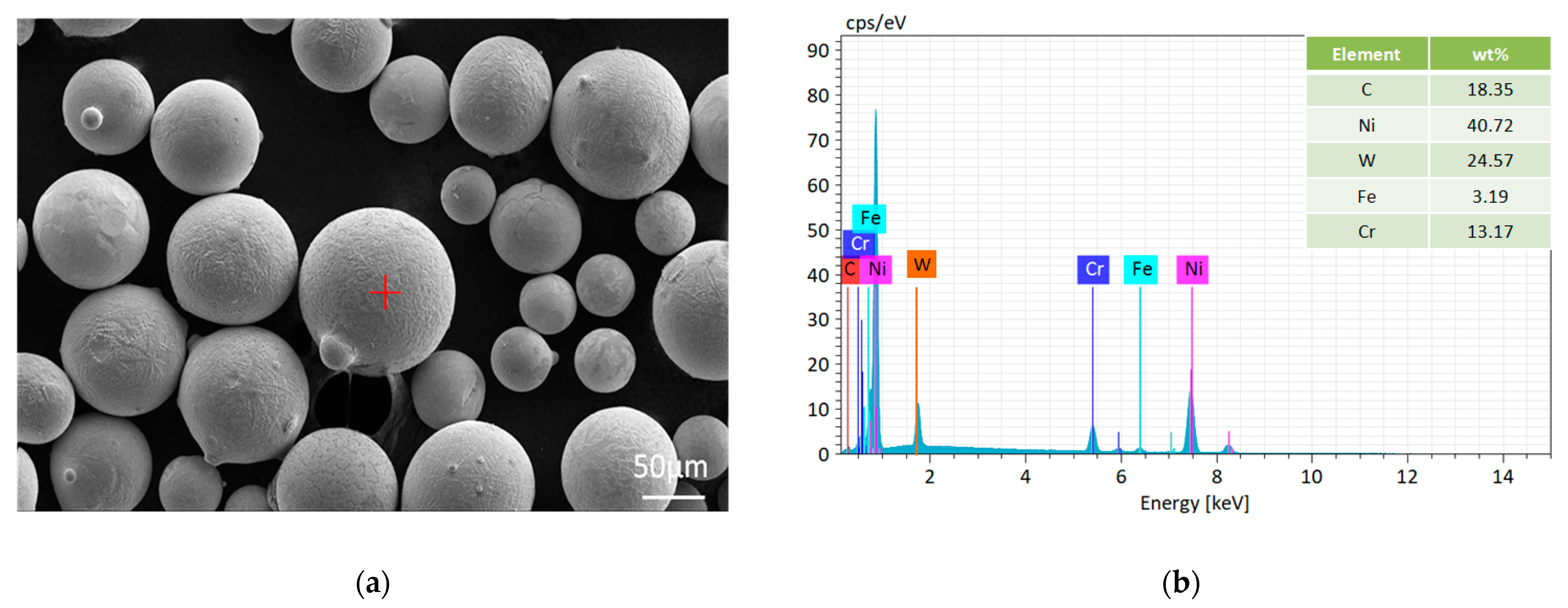

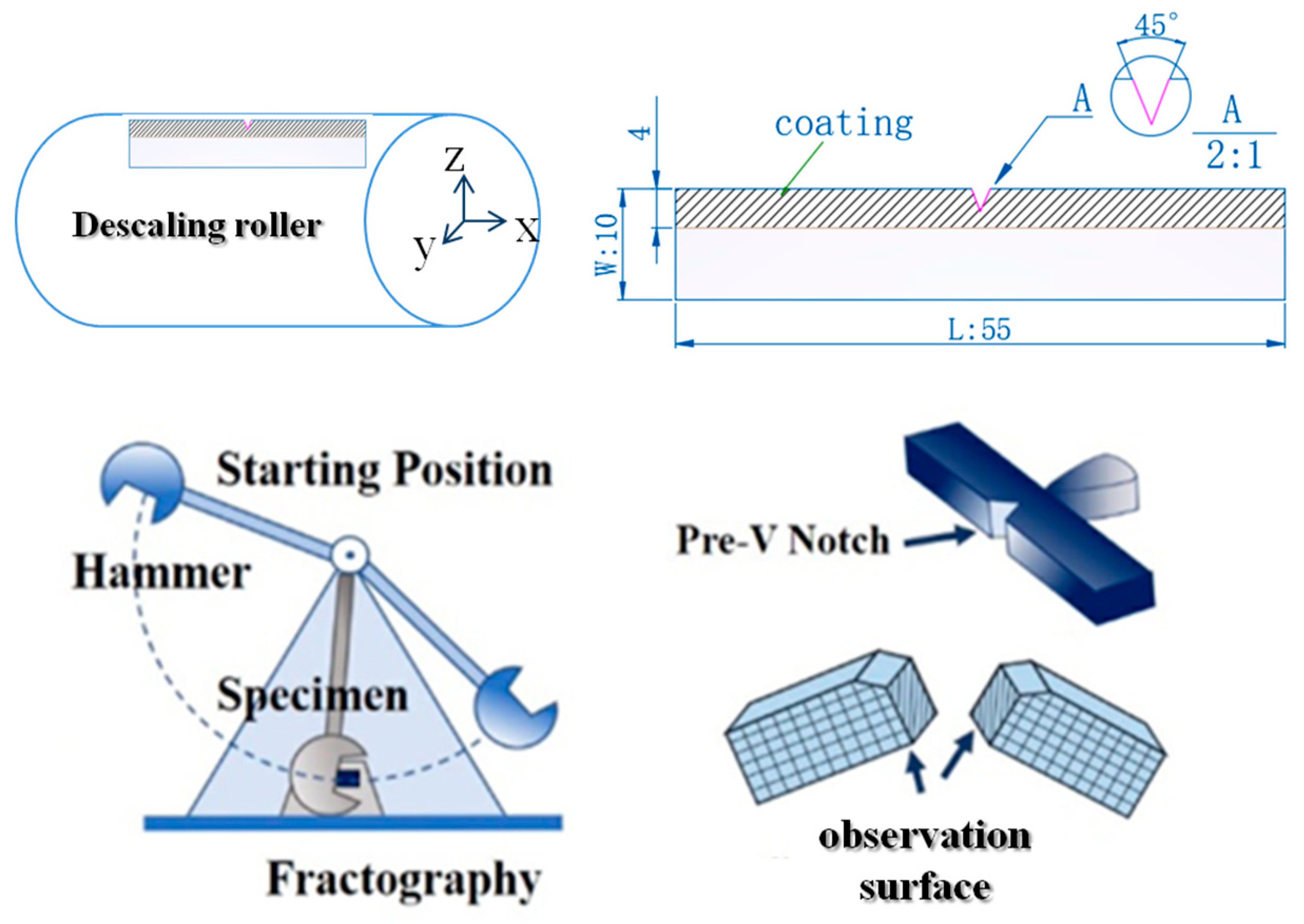
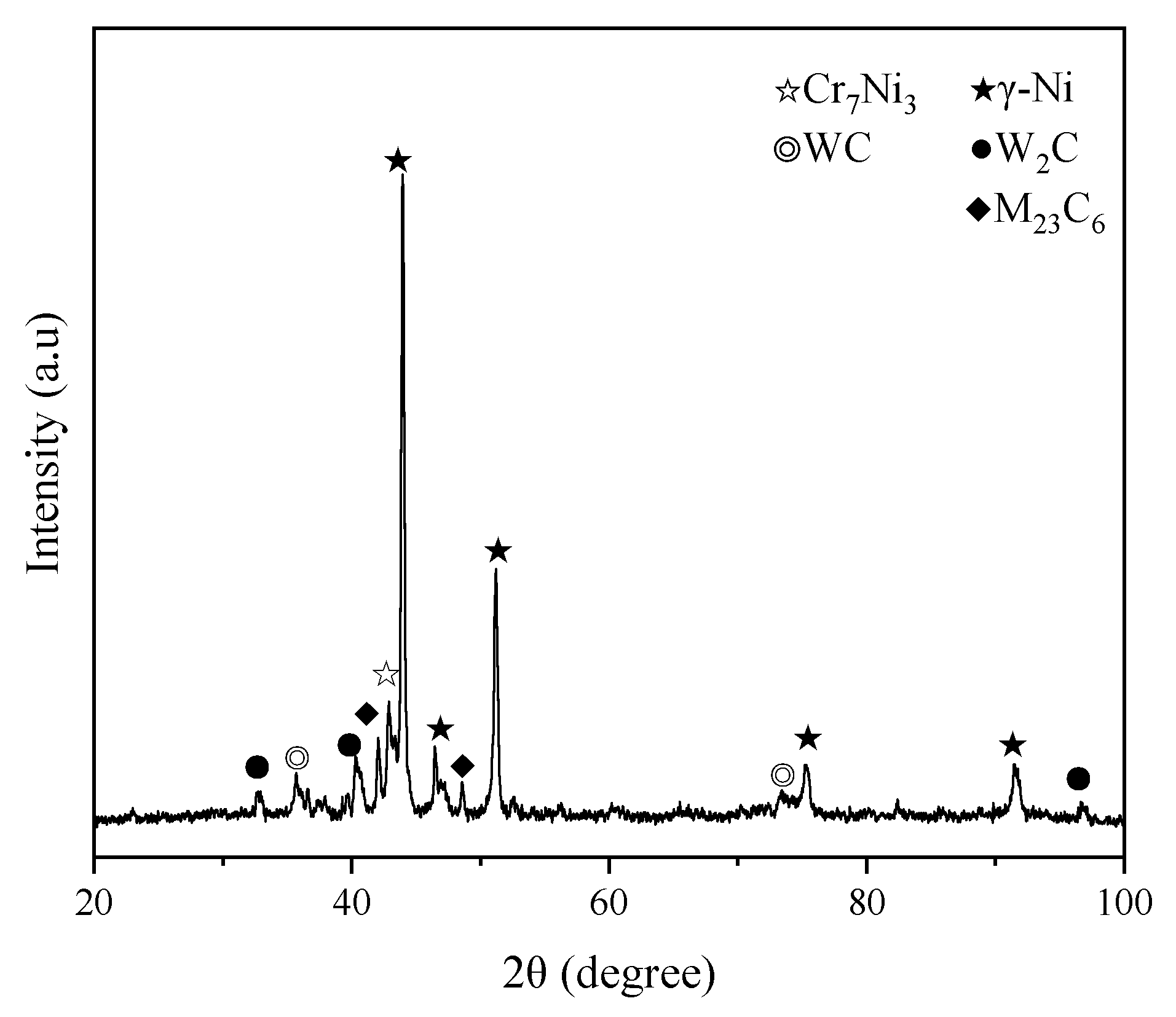
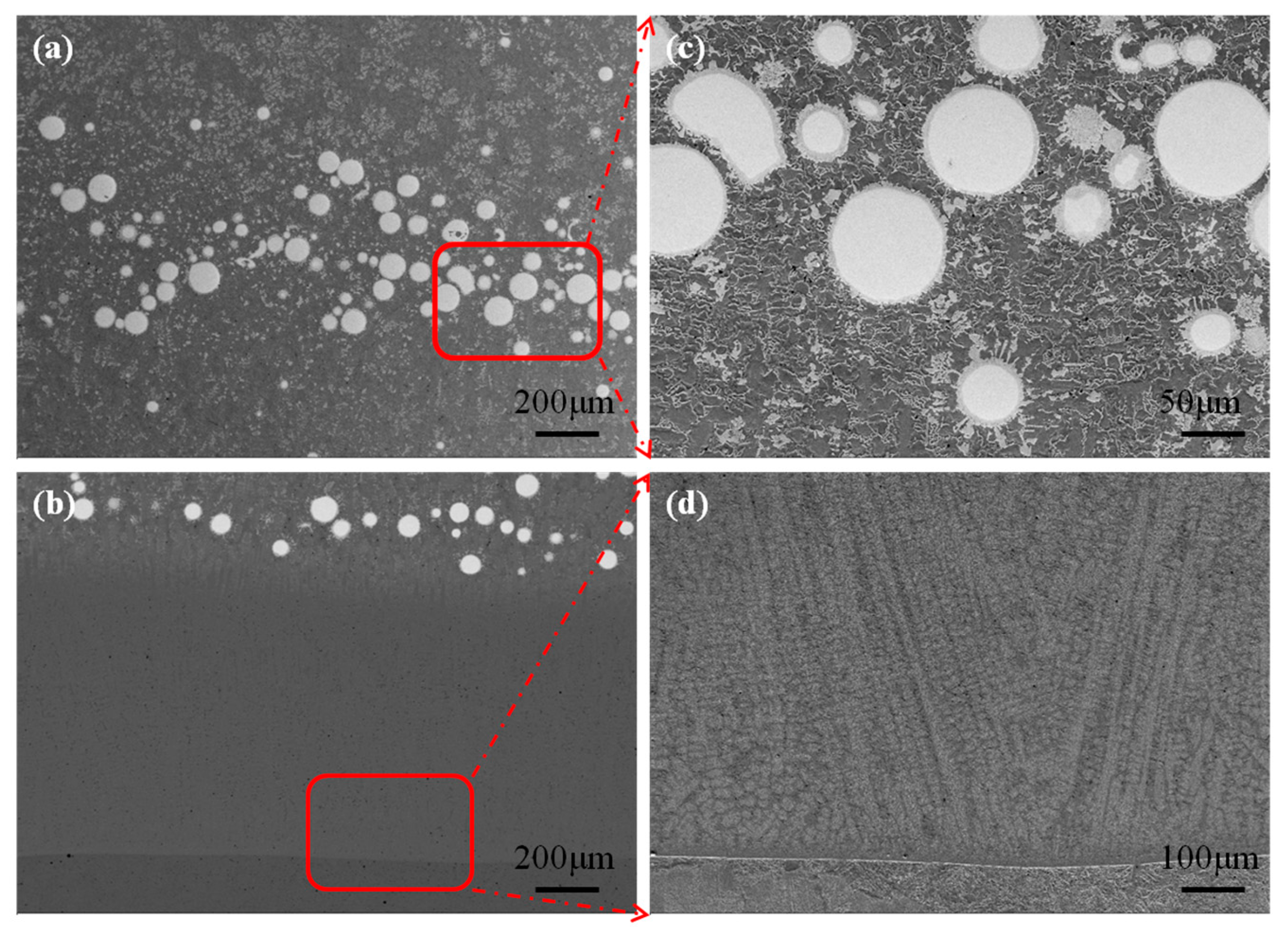


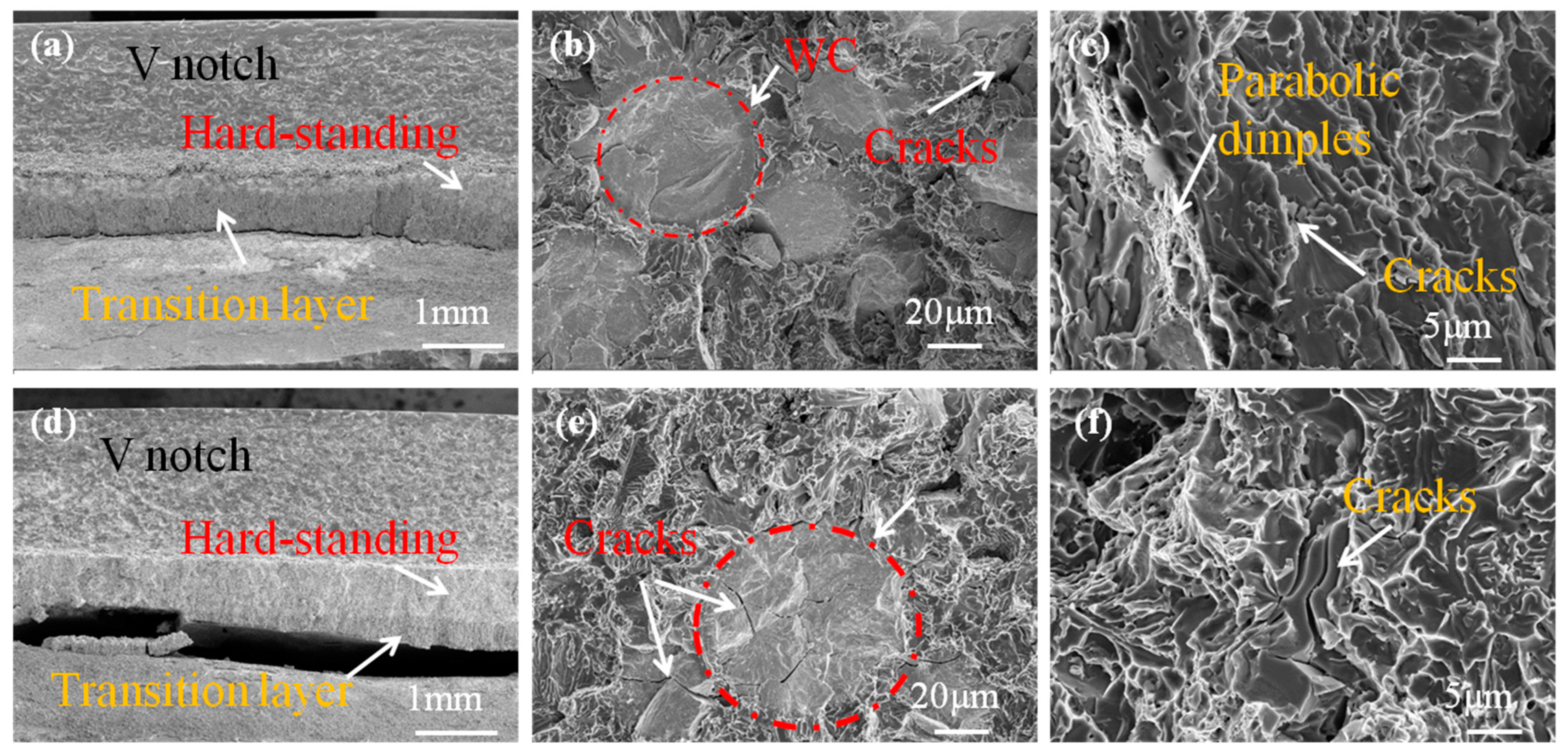

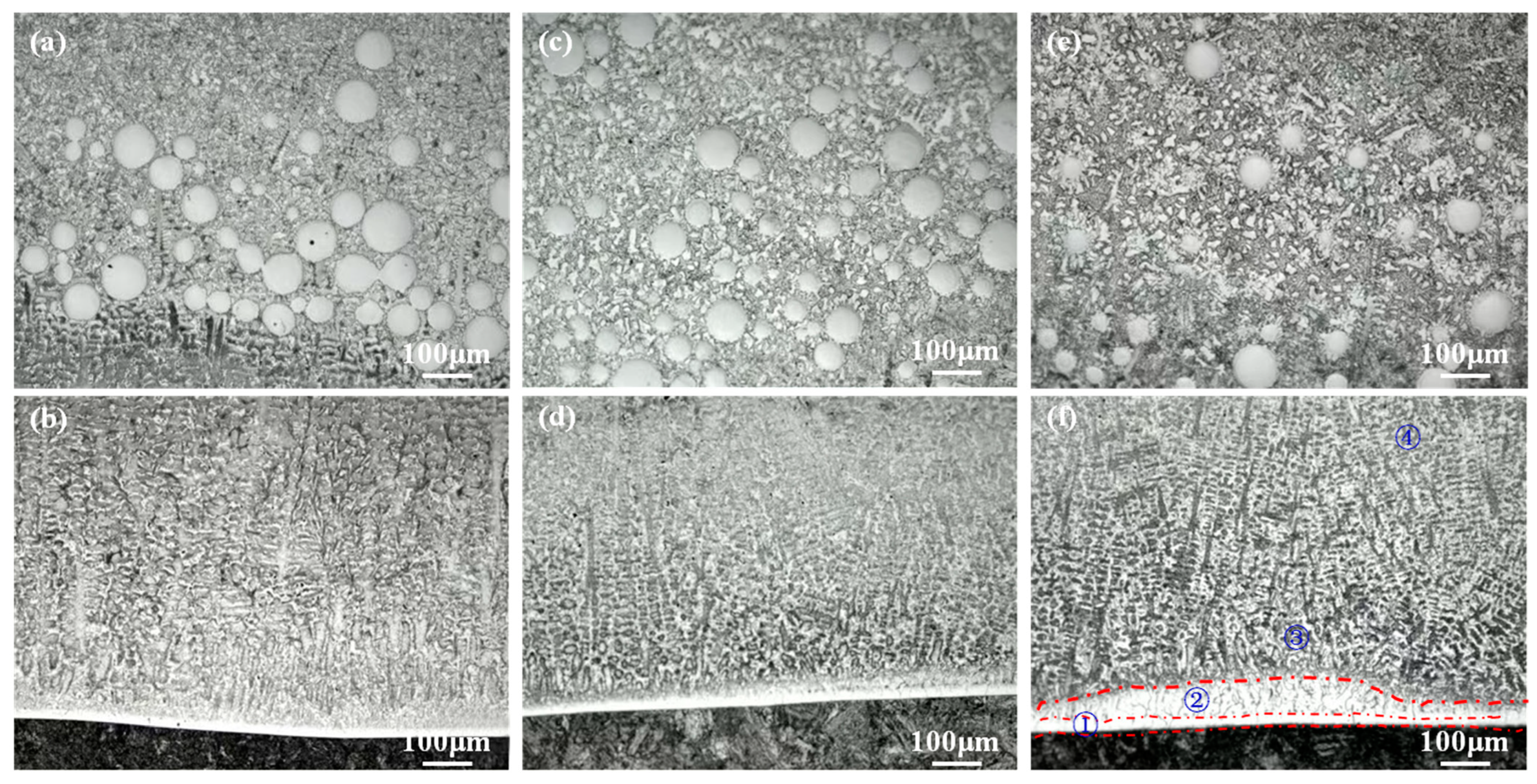
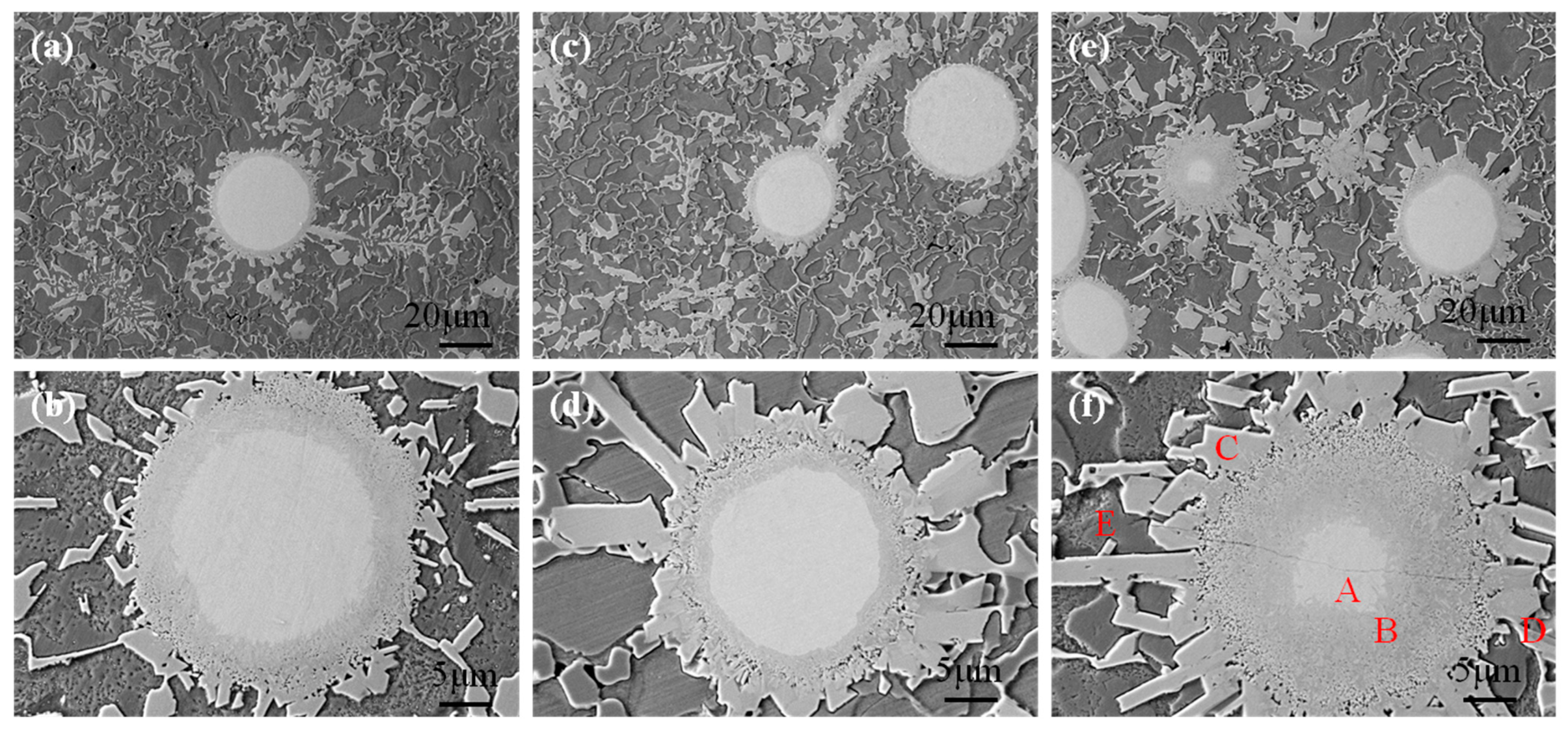
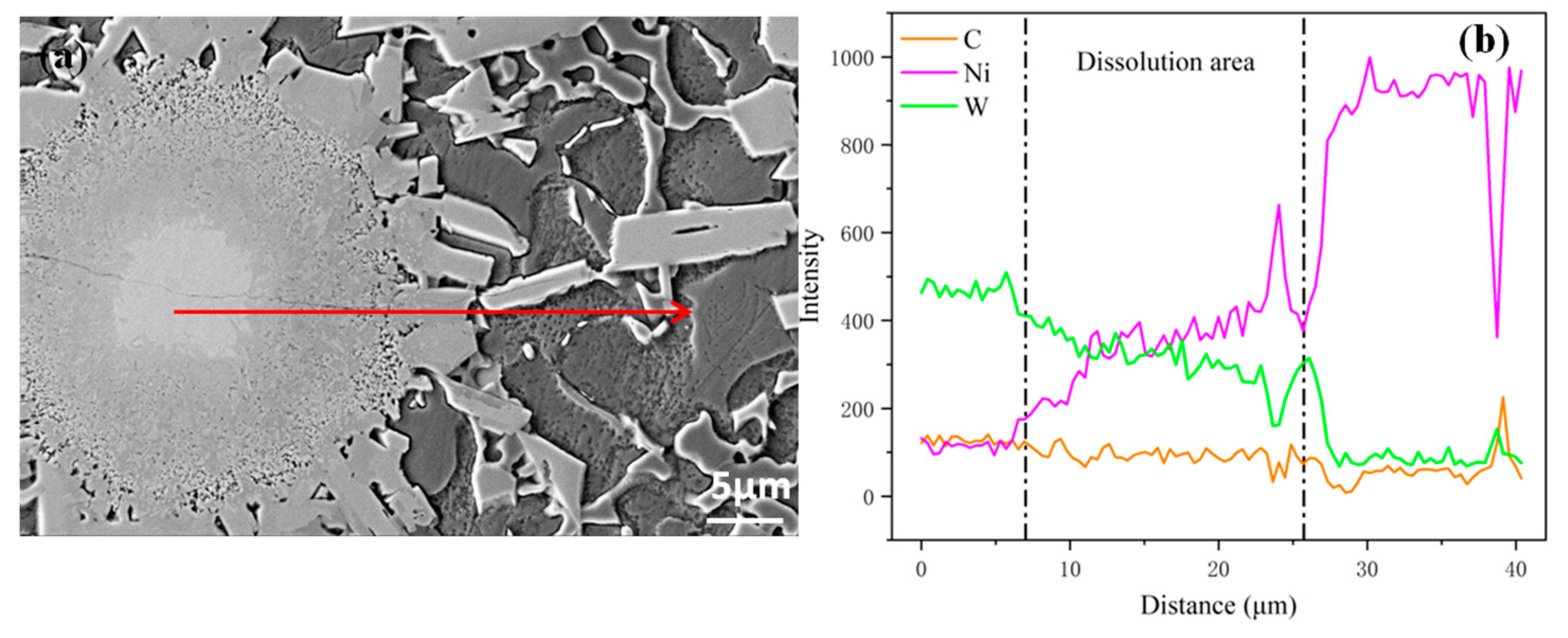
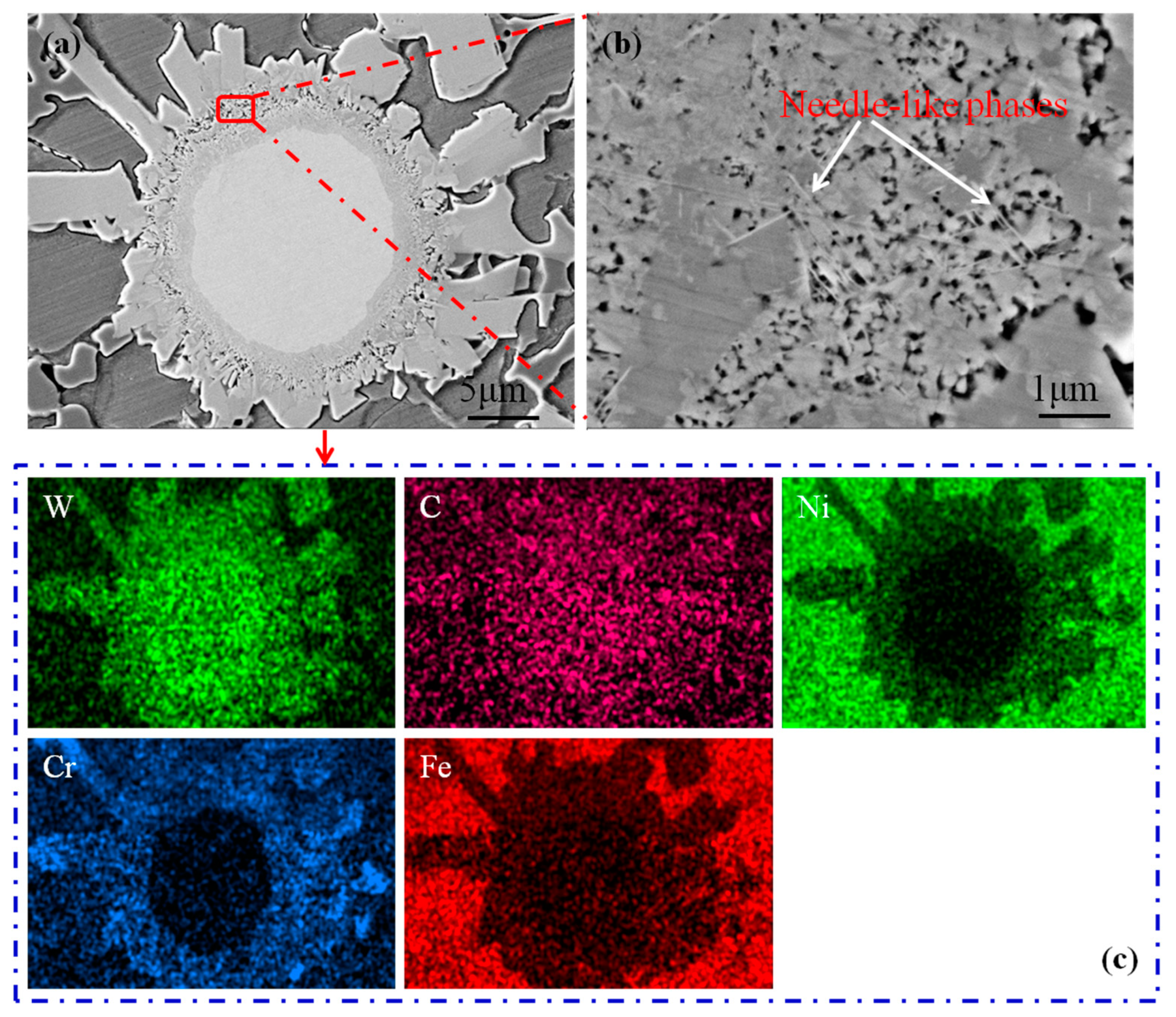


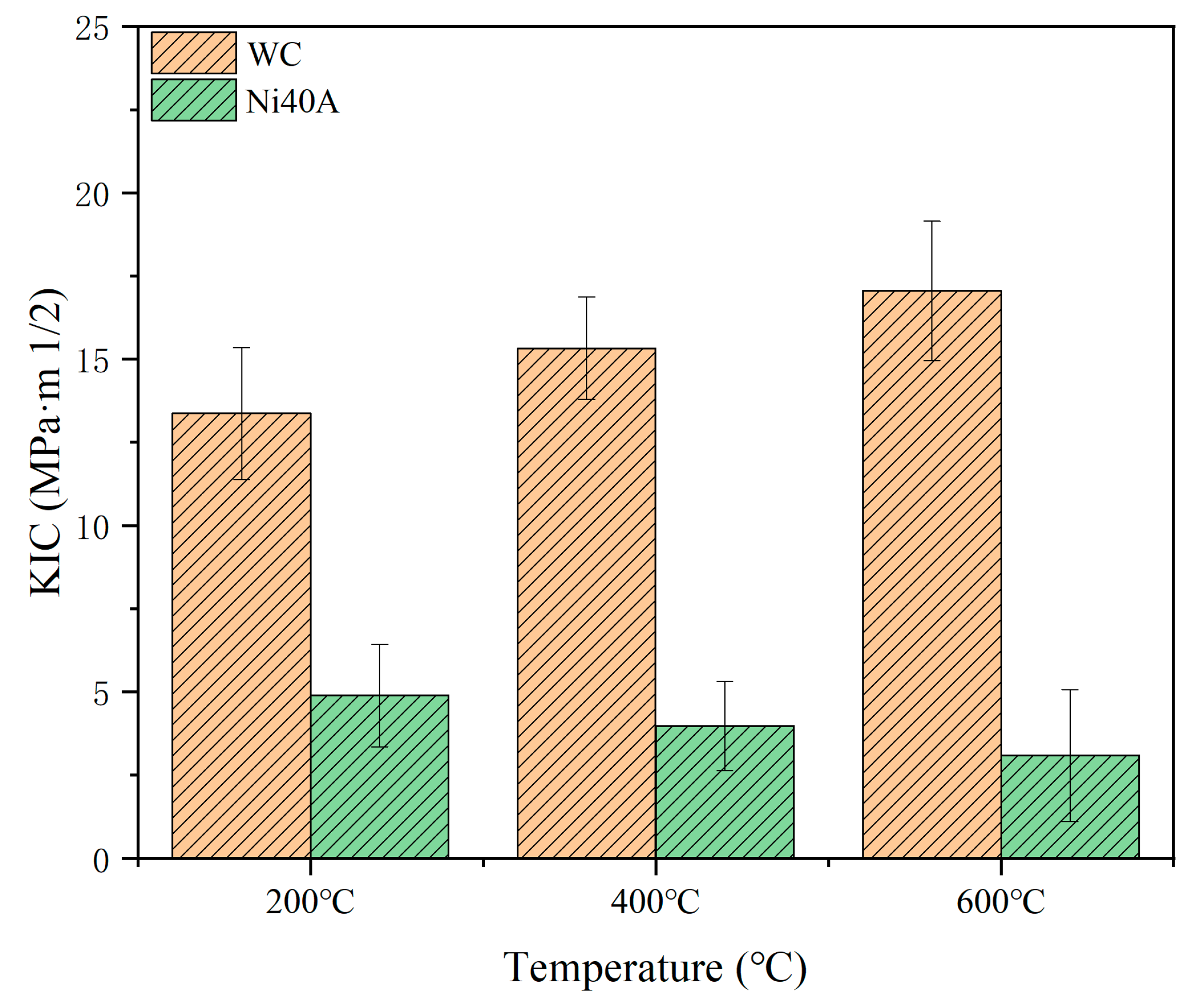
| C | Mn | Si | Cr | Mo | Ni | V | Cu | P | S | Fe |
|---|---|---|---|---|---|---|---|---|---|---|
| 0.42 | 0.55 | 0.26 | 0.98 | 0.16 | 0.02 | 0.01 | 0.01 | 0.011 | 0.015 | Base |
| Layers | |
|---|---|
| Pulsating direct current: | 140 A, with a frequency of 50 Hz |
| Trajectory: | swing step 20 mm |
| swing length 471 mm | |
| Serving: | 42 g·min−1 |
| At.% | C | Cr | Fe | Ni | W |
|---|---|---|---|---|---|
| A | 52.54 | - | - | - | 47.46 |
| B | 28.38 | 12.75 | 10.55 | 21.85 | 26.47 |
| C | 29.65 | 18.02 | 8.23 | 25.90 | 18.20 |
| D | 17.01 | 3.80 | 20.36 | 58.83 | - |
| E | 12.46 | 6.75 | 26.57 | 54.21 | - |
Disclaimer/Publisher’s Note: The statements, opinions and data contained in all publications are solely those of the individual author(s) and contributor(s) and not of MDPI and/or the editor(s). MDPI and/or the editor(s) disclaim responsibility for any injury to people or property resulting from any ideas, methods, instructions or products referred to in the content. |
© 2023 by the authors. Licensee MDPI, Basel, Switzerland. This article is an open access article distributed under the terms and conditions of the Creative Commons Attribution (CC BY) license (https://creativecommons.org/licenses/by/4.0/).
Share and Cite
Zhang, L.; Li, S.; Zhang, C.; Ai, X.; Xie, Z. Microstructure and Mechanical and Impact Behaviors of WC-Particle-Reinforced Nickel-Based Alloy Surfacing Layers at Evaluated Temperatures. Metals 2023, 13, 961. https://doi.org/10.3390/met13050961
Zhang L, Li S, Zhang C, Ai X, Xie Z. Microstructure and Mechanical and Impact Behaviors of WC-Particle-Reinforced Nickel-Based Alloy Surfacing Layers at Evaluated Temperatures. Metals. 2023; 13(5):961. https://doi.org/10.3390/met13050961
Chicago/Turabian StyleZhang, Li, Shengli Li, Chunlin Zhang, Xingang Ai, and Zhiwen Xie. 2023. "Microstructure and Mechanical and Impact Behaviors of WC-Particle-Reinforced Nickel-Based Alloy Surfacing Layers at Evaluated Temperatures" Metals 13, no. 5: 961. https://doi.org/10.3390/met13050961
APA StyleZhang, L., Li, S., Zhang, C., Ai, X., & Xie, Z. (2023). Microstructure and Mechanical and Impact Behaviors of WC-Particle-Reinforced Nickel-Based Alloy Surfacing Layers at Evaluated Temperatures. Metals, 13(5), 961. https://doi.org/10.3390/met13050961







